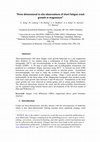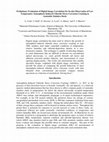Papers by Nicholas Stevens
Key Engineering Materials, Jan 1, 2007
Microstructure can have a significant effect on the resistance to intergranular stress corrosion ... more Microstructure can have a significant effect on the resistance to intergranular stress corrosion cracking. Certain grain boundaries are susceptible to corrosion while others have high resistance and may form crack bridging ligaments as the crack deviates around them. To investigate the mechanics of crack bridging, 3D computational model has been previously developed. An extension to the model, to include stress corrosion crack growth kinetics is presented in this paper. An analysis of the effects of resistant grain boundary fraction demonstrates that the bridging ligaments can significantly retard short crack propagation rates. Increasing the fraction of resistant boundaries is shown to improve microstructure resistance by reducing the crack propagation rate.

A mechanical model for simulating intergranular stress corrosion cracking is presented. The model... more A mechanical model for simulating intergranular stress corrosion cracking is presented. The model has been developed to address the limitations of percolation-like models, which do not account for the mechanical crack driving force and cannot capture experimentally observed phenomena such as the formation of ductile bridging ligaments by resistant boundaries. The model is based on a regular rep- resentation of material microstructure and a categorisation of grain boundaries as susceptible and resistant to corrosion. Crack propagation in two-dimensional microstructures with several fractions of experimentally observed susceptible boundaries is studied. Monte Carlo-type simulations with random distributions of boundaries and a range of susceptible and resistant boundary failure strengths are performed. The effects of crack bridging and crack branching are quantified. It is concluded that together with the fraction of susceptible boundaries, the resistant boundary failure strength is the significant parameter controlling the shielding effect of bridges on crack propagation.

The present paper provides an overview of a new approach which has focused on the behaviour of sp... more The present paper provides an overview of a new approach which has focused on the behaviour of special grain boundaries in sensitised austenitic stainless steel. The aim of the work was to develop a general model for stress corrosion cracking, which would ultimately be capable of predicting the effects of the degree of sensitisation, the connectivity of special boundaries and the influence of stress gradients, such as those developed from surface preparation (machining or peening) or due to the stress concentration effect of pit formation. Experimental work using electron backscatter diffraction analysis and in situ high resolution computed X-ray tomography has correlated cracking with the microstructure in a type 304 austenitic stainless steel. In situ three-dimensional observations demonstrated that annealing twins cause local crack arrest and diversion, leaving non-fractured ligaments in the wake of the cracking path. The mechanical effects of the deformation and failure of these bridges have been modelled, demonstrating that special grain boundaries cause crack tip shielding. Increasing the fraction of special boundaries and decreasing grain size are both predicted to increase stress corrosion cracking resistance. Experimental observations using room temperature intergranular stress corrosion tests and high temperature autoclave tests confirm these predictions for thermomechanically processed microstructures. The effects of applied stress and stress gradients are also predicted by the model, which may be extended to include the kinetics of crack growth, clustering of grain boundary types and variation of the degree of sensitisation.

Three-dimensional (3D) short fatigue crack growth behaviour in a cast magnesium alloy, Elektron 2... more Three-dimensional (3D) short fatigue crack growth behaviour in a cast magnesium alloy, Elektron 21, was studied using a combination of X-ray diffraction contrast tomography (DCT) and microtomography at the European Synchrotron Radiation Facility. A 3D map of grain shapes and crystallographic orientations was produced in a miniature fatigue specimen using DCT. A focused ion beam instrument was used to introduce small notches in selected grains. Synchrotron microtomography was used to study the evolution of fatigue cracks from these notches during interrupted in situ fatigue cycling. Stage I crack growth occurred preferentially on the basal plane of the magnesium hexagonal close packed crystal, with local crack growth rates between 4 and 40 nm cycle-1. Retardations in the local crack growth rate were observed in certain grains and at certain grain boundaries. The observed interactions between the crack and the polycrystalline microstructure can be explained using Schmid factors and a development of the tilt-twist model of Zhai and Wilkinson (Zhai T, Wilkinson AJ, Martin JW. Acta Mater 2000;48;4917)
Conference Papers by Nicholas Stevens

The resistance of polycrystalline materials to intergranular cracking can be influenced by the mi... more The resistance of polycrystalline materials to intergranular cracking can be influenced by the microstructure. In sensitised stainless steels, for example, the grain boundaries prone to sensitisation form paths of low resistance for intergranular stress corrosion cracking. The non-sensitised grain boundaries, such as twin boundaries, have been observed to encourage the formation of crack bridging ligaments. Computational models of intergranular cracking have been developed to investigate the consequences of crack bridging, through its effects on crack propagation in microstructures with different fractions of non- sensitised boundaries. This paper introduces the recently developed two-dimensional model for intergranular cracking with crack bridging, and reports its application to investigate the effect of grain size. It is shown that the size of the crack bridging zone depends on the grain size, and the shielding contribution depends on the relative size of the bridging zone compared to the crack length. It is concluded that both grain refinement and increase in the fraction of resistant boundaries can improve microstructure resistance to intergranular cracking. These observations are consistent with the effects of grain boundary engineering on stress corrosion cracking resistance in sensitized stainless steels.
Intergranular stress corrosion cracking (SCC) of austenitic stainless steel components is a life-... more Intergranular stress corrosion cracking (SCC) of austenitic stainless steel components is a life-limiting factor in nuclear power plant, in which failure of structural components presents a substantial hazard to both safety and economic performance.
This paper reports an on-going research programme into the mechanisms of intergranular stress corrosion cracking in austenitic stainless steels in simulated light water environments. These make use of new analytical and modelling techniques to develop an improved mechanistic understanding of the influence of materials, environment and stress on SCC. The work aims to establish new approaches for the engineering of microstructures and surfaces to develop stainless steels with improved SCC resistance.

The occurrence of Atmospheric-Induced chloride Stress Corrosion Cracking in types 304L and 316L s... more The occurrence of Atmospheric-Induced chloride Stress Corrosion Cracking in types 304L and 316L stainless steels contacted with sea-salt and magnesium chloride deposits has been studied under controlled conditions of relative humidity (ca. 30%) and temperature (80°C). The time to cracking and extent of cracking are shown, at least semi-quantitatively, for specimens contacted with sea-salt deposits to be related to the deposit size prior to environmental exposure with each of these quantities appearing to decrease with decreasing deposit size. For specimens contacted with MgCl2 the quantities correlate with the nominal deposition density decreasing with decreasing deposition density. Specimens of the stainless steels, U-bends and pieces taken from an Intermediate Level Waste container, were also exposed to a marine environment under sheltered and open conditions. Pitting and oxide build up was observed on these specimens after ca. 5 months with pitting occurring to a greater extent on those exposed under the shelter. No cracking was observed after 11 months in the atmospheric exposures.

ECS Transactions, pp119-132, (2010)
Digital image correlation has been used to observe the growth of atmospheric-induced chloride str... more Digital image correlation has been used to observe the growth of atmospheric-induced chloride stress corrosion cracking in type 304L stainless steel under controlled conditions of temperature, relative humidity and chloride-deposition density in a non- destructive manner. The technique is capable of detecting changes in crack dimensions that are difficult to discern via conventional optical microscopy, i.e. crack growth beneath salt layers and adherent corrosion product deposits, and measurement of crack opening displacements. Our results also demonstrate that suitable specimen design, combined with digital image correlation, will provide the means of comparing the growth behaviour of short atmospheric-induced chloride stress corrosion cracks with data obtained from conventional pre-cracked compact tension specimens as a function of mechanical “driving force”

Previously reported high resolution X-ray tomographic observations of intergranular stress corros... more Previously reported high resolution X-ray tomographic observations of intergranular stress corrosion crack growth in sensitised austenitic stainless steel provided evidence that non-sensitised special grain boundaries form crack bridging ligaments along the crack surface. Two and three-dimensional meso-scale computational models of microstructure have been developed, both demonstrating that the phenomenon can be simulated and studied numerically. As 3D models have limitations in terms of computational power and time, full scale studies of the influence of the various model parameters, are reasonable on 2D models at present. A 2D computational model capable of mimicking the real 3D behaviour with crack bridging is presented and used as a simulation tool in this contribution. In terms of geometrical and physical description of the polycrystalline material, this model follows the framework of 2D percolation models used earlier. The material is described as an assembly of regular hexagonal cells, each of which substitutes one grain. The grain boundaries in the assembly are classified in a binary fashion as being either resistant or susceptible to corrosion. In mechanical terms these two types differ in their failure mode. The resistant boundaries are capable of developing inelastic deformations, while susceptible boundaries are assumed pre-oxidised and able to fail in a brittle manner. Crack propagation is a result of a sequence of grain boundaries failures decided from finite element calculations for equilibrium of the assembly with prescribed boundary conditions. Several experimentally determined fractions of resistant boundaries are considered. A number of random distributions of these in the assembly are studied. Results demonstrate crack propagation with branching and bridging comparable qualitatively to experimental observation. The influence of crack bridging on local crack driving force for various resistant boundaries fractions as well as susceptible and resistant boundaries strengths is presented and discussed.










Uploads
Papers by Nicholas Stevens
Conference Papers by Nicholas Stevens
This paper reports an on-going research programme into the mechanisms of intergranular stress corrosion cracking in austenitic stainless steels in simulated light water environments. These make use of new analytical and modelling techniques to develop an improved mechanistic understanding of the influence of materials, environment and stress on SCC. The work aims to establish new approaches for the engineering of microstructures and surfaces to develop stainless steels with improved SCC resistance.
This paper reports an on-going research programme into the mechanisms of intergranular stress corrosion cracking in austenitic stainless steels in simulated light water environments. These make use of new analytical and modelling techniques to develop an improved mechanistic understanding of the influence of materials, environment and stress on SCC. The work aims to establish new approaches for the engineering of microstructures and surfaces to develop stainless steels with improved SCC resistance.